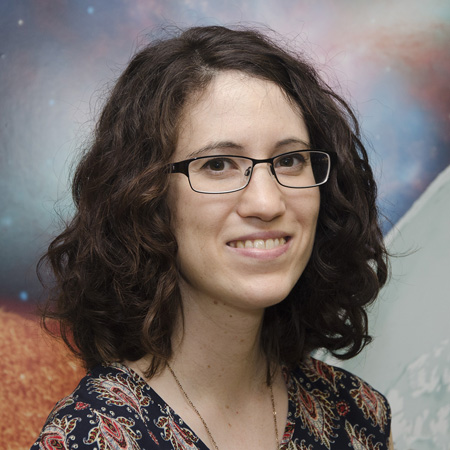Observations of Solar System planets and moons are used to explore processes and remote-sensing discriminants for habitable environments, and as exoplanet model validation. We have we addressed these goals using observations of Europa, models and observations of Venus, and the properties of Earth, Mercury, Mars, and the asteroid belt.
Krissansen-Totton et al. (2016) collated spectra of planets in our Solar System with a large number of VPL planetary spectral models to determine optimum filter bands for discrimination of Earth-like spectra from other planetary types. These authors found that, for exoplanet observations in which noise is dominated by dark current, planet color can provide an efficient means of preliminary characterization.
Earth as an Exoplanet
The VPL team has developed a well-validated 3-D spectral Earth model to produce a definitive dataset of the photometric and spectral characteristics for the Earth as seen in direct imaging and transit.
The VPL Earth model is now the most comprehensive and rigorous model of its type, simulating reflectance and emission from realistic planetary surfaces, with line-by-line treatment of atmospheric emission, absorption and scattering, and explicit phase dependent scattering from realistic clouds. The model outputs spatially- and spectrally-resolved synthetic observations of Earth, including disk-integrated photometry and spectra, for an arbitrary observational vantage point. It can be used to explore the appearance of Earth over all observed phases (from full to crescent), throughout any wavelength interval from the far UV to the far-IR, and on timescales from hours to years (Robinson et al., 2011; Misra et al., 2012).
The model has been extensively validated from the ultraviolet to the thermal infrared, and is in excellent agreement with data from NASA’s Atmospheric Infrared Sounder (Aqua/AIRS), and temporally- and spectrally-resolved observations of Earth from NASA’s Deep Impact flyby spacecraft (a VPL collaboration with the NASA EPOXI mission) (Robinson et al., 2011). The model has also been validated as a function of phase using Earthshine and EPOXI data (Robinson et al., 2010).
Products from the Earth model can be used to explore the detectability of signs of habitability and life for the Earth, to validate the retrieval techniques developed in Task E, and to expand our 3-D spectral visualization capability to planets other than the Earth. We are currently working on upgrades to the Earth model that will further increase its versatility.
Highlights of scientific applications of the VPL 3-D Spectral Earth model are described below.
First Detection Of Earth’s Primary Atmospheric Gas In Disk Spectrum
In Schwieterman et al. (2015b), VPL team members made the first-ever detection of an absorption feature in Earth’s whole-disk spectrum due to molecular nitrogen (N2). This feature—the 4.2 μm N2-N2 collision-induced absorption band—was found using comparisons between observations of the distant Earth from NASA’s EPOXI mission and simulations from the VPL 3-D spectral Earth model. Molecular nitrogen can be a major constituent in planetary atmospheres, but its abundance is notoriously difficult to constrain due to a lack of spectral features. Thus, this work provides a new means for determining N2 concentrations in exoplanet atmospheres, which could be used to constrain surface pressure (thus helping to indicate liquid water stability) and could also rule out certain mechanisms for producing abiotic atmospheric oxygen.
Detecting Alien Oceans Using Glint
In Robinson et al. (2010), we used the Earth model to simulate Earth’s appearance in reflected light over a year, including the realistic evolution of cloud, snow, and sea ice cover. We used this VPL-generated dataset (which is publicly available on this website) to investigate the detectability of “glint”, the mirror-like reflection of sunlight off a body of water, in the Earth’s disk-integrated brightness. Including the possibly confusing effects of realistic forward scattering clouds, our models of the Earth’s phase-dependent brightness show that the crescent-phase Earth is as much as 100% brighter than an identical non-glinting Earth at some near-infrared wavelengths. Such an excess in brightness may be detectable by NASA’s James Webb Space Telescope if it were to fly with an external occulter.
In collaboration with LCROSS mission scientists, Robinson et al. (2014) compared predictions from the VPL 3-D spectral Earth model with UV to infrared spectra of the Earth obtained by the LCROSS mission. This comparison was used to validate our predictions of the detectability and spectral dependence of glint from the Earth’s ocean, and it also revealed an error in the spectral calibration of data from the LCROSS mission, which we were able to help correct.
Detecting Exomoons
The VPL 3-D Spectral Earth model has also been used to explore the detectability of a moon around an Earth-like exoplanet as a function of wavelength and observed phase (i.e. whether the exoEarth and moon are observed at full, or near crescent phase) (Robinson, 2011). The models showed that the contribution of the exomoon to the exoEarth spectrum is very strongly phase dependent, and more likely to be detectable in the exoEarth’s carbon dioxide absorption bands.

Earth In Transmission
Recently, we modified our line-by-line radiative transfer model to simulate transmission spectroscopy, that is, the backlighting of a planet’s atmosphere seen when it passes in front of its parent star. This work was validated against ATMOS-1 observations of the Earth’s transmission, and is currently being used to determine sensitivity to atmospheric pressure (Misra et al., 2011; Misra et al., 2012).
Venus as an Exoplanet
We study Venus to understand what can happen to an evolved, runaway terrestrial planet. Arney et al. (2014) published work on the first simultaneous near-infrared spectral mapping observations of the Venus atmosphere, an analog for a hot, haze-covered planet. These observations were used to produce simultaneous spatially-resolved maps of H2O, HCl, CO, OCS, and SO2 abundances in the Venusian lower atmosphere, revealing unexpected dichotomies, and showing spatial correlations that were indicative of chemical interactions between several atmospheric species. Gao et al. (2014) validated a generalized 1-D microphysical and vertical transport cloud model for use in the VPL 1-D Climate Model against Venus data, and revealed an oscillatory “rain out” of the Venus clouds in the process.
Titan as an Exoplanet
Saturn’s giant moon, Titan, represents a very alien world, where methane exists in multiple phases, rather than water.
Robinson et al. (2014) used Cassini occultation observations of Titan to simulate a transit transmission observation of a haze-enshrouded world. The observations showed a strong slope in the spectrum due to the hydrocarbon haze, and these data were combined with our existing knowledge of the Titan atmosphere to quantify the atmospheric depths probed in transit transmission.
Charnay et al. (2015) explained the observed eastward propagation of dunes on this planet using a coupling between tropical methane storms and superrotation. This work provides insights into volatile cycles on dry planets, as might occur for habitable worlds that form dry or lose most of their water.

Click to See Researchers Working on This Task
Email: tyler.robinson@nau.edu Website Publications VPL Focus: Task A (Lead)
Bio: I am a scientist whose research interests include planetary science, exoplanets, planetary climate, remote sensing, radiative transfer, atmospheric characterization, high contrast imaging, observational astronomy, brown dwarfs habitability, and astrobiology. I have worked on a variety of interdisciplinary projects, both as a scientist and as an educator. My recent work has focused on using data and models from the Earth, atmospheric, and planetary sciences to better understand characterization techniques for exoplanets.
Email: giada.n.arney@nasa.gov
Website:
CV / Publications: https://science.gsfc.nasa.gov/sed/bio/giada.n.arney
VPL Focus: Task A, Task B (Lead), Task E
Bio:
My research has involved modeling and measuring properties of planets with an emphasis on worlds enshrouded by global cloud and haze layers because aerosols appear to be a common planetary phenomeon. I have a dual focus on both solar system bodies and on exoplanets. I have retrieved properties of Venus’ sub-cloud atmosphere through observations of its nightside spectral windows, producing the first simultaneous and temporally resolved maps of cloud opacity, acid concentration, water vapor (H2O), hydrogen chloride (HCl), carbon dioxide (CO), carbonyl sulfide (OCS), and sulfur dioxide (SO2). I also have extensive modeling experience of planetary atmospheres and have comprehensively simulated hazy Archean Earth with a coupled photochemical-climate model to study its atmospheric composition, climate, and habitability. Using a sophisticated radiative transfer model together with a coronagraph noise model and a JWST model, I showed that organic haze on an Earthlike planet produces strong spectral signatures that may be detectable with future telescopes. In addition, I helped lead a paper on Proxima Centauri b’s possible climatic and environmental states and their spectral discriminants, and I have been involved in work identifying oxygen false positive biosignature signals. My current and near-future research focuses on modeling the atmospheric and climatic states of exoplanets, understanding the observational requirements to discriminate between different planetary states with current and future observatories, and re-visiting Venus with new observations.
Email: j.bailey@unsw.edu.au
VPL Focus: Task A, Task E
Bio:
Email: david.crisp@jpl.nasa.gov
VPL Focus: Task E (Lead)
Bio:
Dr. David Crisp is an atmospheric physicist and a Senior Research Scientist at the Jet Propulsion Laboratory, California Institute of Technology.
Since receiving his Ph.D. from the Geophysical Fluid Dynamics Program at Princeton University in 1984, he has focused primarily on the development of radiative transfer algorithms for remote sensing and climate models of Venus, Earth, and Mars. Dr. Crisp has served on the science teams of several missions including the Venus VEGA Balloon Mission, Hubble Space Telescope Wide Field/Planetary Camera 2 (WFPC2), Mars Pathfinder Lander Atmospheric Structure Instrument, Mars Polar Lander MVACS Meteorology Experiment, and ESA Venus Express. He contributed to the NASA technology program by developing in situ atmospheric structure and meteorological instruments and serving as the Chief Scientist of the NASA New Millennium Program, from 1998 to 2001.
Dr. Crisp was the Principal Investigator of the Earth System Science Pathfinder (ESSP) Orbiting Carbon Observatory (OCO) mission, NASA’s first dedicated carbon dioxide measurement mission. He is currently serving as the Science Lead of the OCO-2 Mission.
Email: mcurr@uw.edu
VPL Focus: Task A, Task E
Bio:
Email: fengding@seas.harvard.edu
VPL Focus: Task A, Task C
Bio:
I am interested in exploring diverse planetary climate states by building simple models. Currently, I am working on the climate in condensible-rich atmospheres and the implication for habitability of exoplanets.
Email: gaopeter@berkeley.edu
VPL Focus: Task A
Bio:
I am currently a 51 Pegasi b Postdoctoral Fellow at the University of California, Berkeley. My research focuses on aerosols and chemistry in planetary atmospheres within and beyond the Solar System.
I recieved my PhD in Planetary Science from Caltech, where I worked on modeling the clouds and hazes of Venus, Titan, and Pluto, and the atmospheric evolution of terrestrial worlds orbiting M dwarf stars. After graduation I spent a year at NASA Ames Research Center, where I continued my journey into the study of exoplanet atmospheres.
Email: jkt@ucsc.edu
VPL Focus: Task A, Task B
Bio:
I am a planetary scientist and astrobiologist from New Zealand, currently living in San Jose. You can read more about my scientific background here. I am a theoretician, and so the pictures below are thoroughly unrepresentative of my day job!
Email: meadows@uw.edu
Website:
Bio:
Victoria Meadows is an astrobiologist and planetary astronomer whose research interests focus on acquisition and analysis of remote-sensing observations of planetary atmospheres and surfaces. In addition to studying planets within our own Solar System, she is interested in exoplanets, planetary habitability and biosignatures. Since 2000, she has been the Principal Investigator for the Virtual Planetary Laboratory Lead Team of the NASA Astrobiology Institute. Her NAI team uses models of planets, including planet-star interactions, to generate plausible planetary environments and spectra for extrasolar terrestrial planets and the early Earth. This research is being used to help define signs of habitability and life for future extrasolar terrestrial planet detection and characterization missions.
Email: eschwiet@ucr.edu
VPL Focus: Task A, Task B, Task D
Bio:
I’m a member of the UCR Alternative Earths Team at the University of California, Riverside. My supervisor is Dr. Timothy Lyons. I’m also a member of the Virtual Planetary Laboratory. My research interests and activities include studying Earth as an exoplanet (throughout geologic time), determining planetary properties from disk-integrated spectra, climate, photochemical, and radiative transfer modeling of terrestrial planet atmospheres, and generating synthetic spectra of model exoplanets. I’m particularly interested in work that can inform our ability to characterize Earth-sized planets that reside in the habitable zones of their host stars, especially in search of remotely detectable biosignatures.
Email: antigona@nucleares.unam.mx
VPL Focus: Task A, Task C, Task E
Bio:
Full time senior researcher at the Instituto de Ciencias Nucleares, Universidad Nacional Autónoma de México. Permanent position.
Education:
- Ph.D. (Space Physics) with Honorific Mention. Thesis: Nitrogen fixation by volcanic lightning on early Mars. Universidad Nacional Autónoma de México, México, 2001.
- M. Sc. (Astronomy). Universidad Nacional Autónoma de México (UNAM), Mexico, 1997. Obtained by general exams. * Specialization on Popularization of Science. Universidad Nacional Autónoma de México, Mexico, 1998.
- B. Sc. (Physics). Universidad Autónoma de San Luis Potosí, Mexico, 1994. Thesis: Polarizabilidad de Mie en tres diferentes teorías de Campo Medio (Mie polarization on three different mean field theories).
Email: sparks@stsci.edu
VPL Focus: Task A
Bio:
Bill Sparks is an astronomer who has been at the Space Telescope Science Institute since his early days as a postdoc in 1986. He is a currently the deputy division head for the Instruments Division and is a member of the Advanced Camera for Surveys Instrument Definition Team (ACS IDT). He has done much scientific work with active galaxies. His scientific interests include characteristics of radio galaxies and jets, X-ray emission in galaxy clusters, and astrobiology.
Email: Amber_Young@nau.edu
VPL Focus: Task A
Bio:
As a Master’s student at Fisk, I studied the potential biosignatures of the Martian atmosphere using computational modeling techniques. I completed the Master’s Phase of the Bridge Program in June 2019, and am now a graduate research assistant at Northern Arizona University where I study the potential biosignatures of exoplanets using atmospheric modeling.















